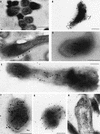Mycobacterial stationary phase induced by low oxygen tension: cell wall thickening and localization of the 16-kilodalton alpha-crystallin homolog
- PMID: 9473032
- PMCID: PMC106957
- DOI: 10.1128/JB.180.4.801-808.1998
Mycobacterial stationary phase induced by low oxygen tension: cell wall thickening and localization of the 16-kilodalton alpha-crystallin homolog
Abstract
Most cases of tuberculosis are due to reactivation of endogenous infection which may have lain quiescent or dormant for decades. How Mycobacterium tuberculosis survives for this length of time is unknown, but it is hypothesized that reduced oxygen tension may trigger the tubercle bacillus to enter a state of dormancy. Mycobacterium bovis BCG and M. tuberculosis H37Rv were cultured under aerobic, microaerobic, and anaerobic conditions. Their ultrastructural morphology was analyzed by transmission electron microscopy (TEM), and protein expression profiles were compared by sodium dodecyl sulfate-polyacrylamide gel electrophoresis (SDS-PAGE). TEM revealed that the microaerobically and anaerobically cultured bacilli but not the aerobically cultured bacilli developed a strikingly thickened cell wall outer layer. The thickening was not observed in aerobically cultured stationary-phase bacilli or in anaerobically cultured Mycobacterium smegmatis. A highly expressed protein was detected by SDS-PAGE in microaerobic and anaerobic cultures and was identified as the 16-kDa small heat shock protein or alpha-crystallin homolog. Immunolocalization by colloidal gold immunoelectron microscopy identified three patterns of protein distribution in M. bovis BCG cultured under low oxygen tension. The 16-kDa protein was strongly associated with the cell envelope, fibrous peptidoglycan-like structures, and intracellular and peripheral clusters. These results suggest that tubercle bacilli may adapt to low-oxygen conditions by developing a thickened cell wall and that the 16-kDa protein may play a role in stabilizing cell structures during long-term survival, thus helping the bacilli survive the low oxygen tension in granulomas. As such, the cell wall thickening and the 16-kDa protein may be markers for the dormant state of M. tuberculosis.
Figures



Similar articles
-
Tubercle bacilli generate a novel cell wall-associated pigment after long-term anaerobic culture.FEMS Microbiol Lett. 2004 Jun 1;235(1):191-8. doi: 10.1016/j.femsle.2004.04.036. FEMS Microbiol Lett. 2004. PMID: 15158281
-
Protein synthesis is shutdown in dormant Mycobacterium tuberculosis and is reversed by oxygen or heat shock.FEMS Microbiol Lett. 1998 Jan 1;158(1):139-45. doi: 10.1111/j.1574-6968.1998.tb12813.x. FEMS Microbiol Lett. 1998. PMID: 9453166
-
Mycobacterium bovis BCG response regulator essential for hypoxic dormancy.J Bacteriol. 2002 Dec;184(24):6760-7. doi: 10.1128/JB.184.24.6760-6767.2002. J Bacteriol. 2002. PMID: 12446625 Free PMC article.
-
Stationary phase-associated protein expression in Mycobacterium tuberculosis: function of the mycobacterial alpha-crystallin homolog.J Bacteriol. 1996 Aug;178(15):4484-92. doi: 10.1128/jb.178.15.4484-4492.1996. J Bacteriol. 1996. PMID: 8755875 Free PMC article.
-
Role of alpha-crystallin, early-secreted antigenic target 6-kDa protein and culture filtrate protein 10 as novel diagnostic markers in osteoarticular tuberculosis.J Orthop Translat. 2016 Jan 25;6:18-26. doi: 10.1016/j.jot.2016.01.001. eCollection 2016 Jul. J Orthop Translat. 2016. PMID: 30035079 Free PMC article. Review.
Cited by
-
Dissecting mechanisms of immunodominance to the common tuberculosis antigens ESAT-6, CFP10, Rv2031c (hspX), Rv2654c (TB7.7), and Rv1038c (EsxJ).J Immunol. 2012 May 15;188(10):5020-31. doi: 10.4049/jimmunol.1103556. Epub 2012 Apr 13. J Immunol. 2012. PMID: 22504645 Free PMC article.
-
A cytoplasmic peptidoglycan amidase homologue controls mycobacterial cell wall synthesis.Elife. 2016 Jun 15;5:e14590. doi: 10.7554/eLife.14590. Elife. 2016. PMID: 27304077 Free PMC article.
-
Deciphering the virulence factors of the opportunistic pathogen Mycobacterium colombiense.New Microbes New Infect. 2016 Sep 10;14:98-105. doi: 10.1016/j.nmni.2016.09.007. eCollection 2016 Nov. New Microbes New Infect. 2016. PMID: 27818776 Free PMC article.
-
CD4+ T Responses Other Than Th1 Type Are Preferentially Induced by Latency-Associated Antigens in the State of Latent Mycobacterium tuberculosis Infection.Front Immunol. 2019 Nov 29;10:2807. doi: 10.3389/fimmu.2019.02807. eCollection 2019. Front Immunol. 2019. PMID: 31849981 Free PMC article.
-
Fighting Tuberculosis: In Search of a BCG Replacement.Microorganisms. 2022 Dec 23;11(1):51. doi: 10.3390/microorganisms11010051. Microorganisms. 2022. PMID: 36677343 Free PMC article. Review.
References
-
- Bloom B R, Murray J L. Tuberculosis: commentary on a reemergent killer. Science. 1992;257:1055–1064. - PubMed
-
- Brennan P, Nikaido H. The envelope of mycobacteria. Annu Rev Biochem. 1995;64:29–63. - PubMed
-
- Buchner J. Supervising the fold: functional principles of molecular chaperones. FASEB J. 1996;10:10–19. - PubMed
-
- Caspers G-J, Leunissen J A M, de Jong W W. The expanding small heat shock family, and structure predictions of the conserved “α-crystallin domain”. J Mol Evol. 1995;40:238–248. - PubMed
Publication types
MeSH terms
Substances
Grants and funding
LinkOut - more resources
Full Text Sources
Other Literature Sources
Research Materials

